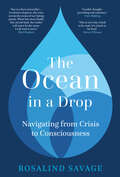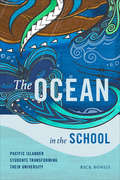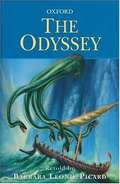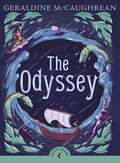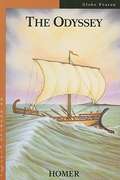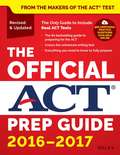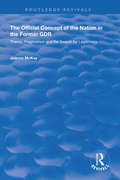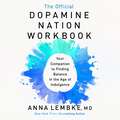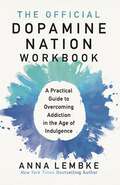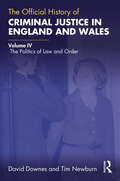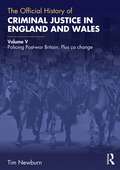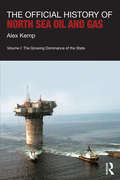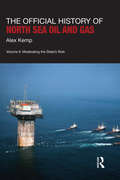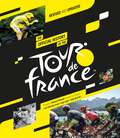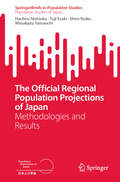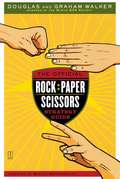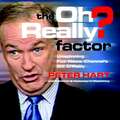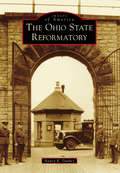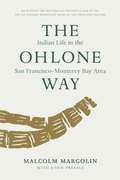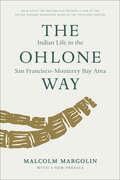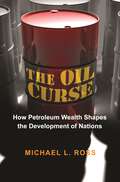- Table View
- List View
The Ocean in a Drop: Navigating from Crisis to Consciousness
by Roz SavageThe bad news is that our civilisation is collapsing. The good news is that you are already helping create a new and better one.The Ocean in a Drop follows the quest of Roz Savage, a frustrated environmentalist and ocean adventurer, to find out why her own endeavours and the environmental movement more generally have failed to achieve change of the necessary scope, scale and speed. Her journey takes her from the environment through economics and politics into patriarchy and a global culture of domination – the domination of rich over poor, strong over weak, humanity over nature. She examines the tragic psychological flaws in the way we think, and the apparent inevitability of civilisational collapse, and deduces that our best hope is to transcend the current trap of runaway materialism. But how?Exploring cutting-edge theories on the nature of reality and the relationship between matter and consciousness, she peels back the veils of our shared delusions to arrive at a new narrative about what it means to be human in the twenty-first century. She paints a bold, exciting vision of a future in which people and planet thrive.
The Ocean in the School: Pacific Islander Students Transforming Their University
by Rick BonusIn The Ocean in the School Rick Bonus tells the stories of Pacific Islander students as they and their allies struggled to transform a university they believed did not value their presence. Drawing on dozens of interviews with students he taught, advised, and mentored between 2004 and 2018 at the University of Washington, Bonus outlines how, despite the university's promotion of diversity and student success programs, these students often did not find their education to be meaningful, leading some to leave the university. As these students note, they weren't failing school; the school was failing them. Bonus shows how students employed the ocean as a metaphor as a way to foster community and to transform the university into a space that valued meaningfulness, respect, and critical thinking. In sharing these students' insights and experiences, Bonus opens up questions about measuring student success, the centrality of antiracism and social justice to structurally reshaping universities, and the purpose of higher education.
The Odyssey
by Homer Barbara Leonie PicardAfter the fall of Troy, Odysseus sets sail for his island kingdom of Ithaca, but has to face many dangers and even travels to the underworld, meeting dead Greek heroes. [This text is listed as an example that meets Common Core Standards in English language arts in grades 6-8 at http://www.corestandards.org.]
The Odyssey
by Homer Geraldine MccaughreanThis book describes the epic journey of Odysseus, the hero of Ancient Greece...After ten years of war, Odysseus turns his back on Troy and sets sail for home. But his voyage takes another ten years and he must face many dangers - Polyphemus the greedy one-eyed giant, Scylla the six-headed sea monster and even the wrath of the gods themselves - before he is reunited with his wife and son.
The Odyssey of Homer ( An Adapted Classic)
by Homer Henry I. ChristHomer's great epic describes the many adventures of Odysseus, Greek warrior, as he strives over many years to return to his home island of Ithaca after the Trojan War. His colorful adventures, his endurance, his love for his wife and son have the same power to move and inspire readers today as they did in Archaic Greece, 2800 years ago.
The Odyssey: The Story of Odysseus
by Homer W. H. D. RouseThe story of a Greek legend Odysseus and his adventures on his way home from Troy.
The Official ACT Prep Guide
by Jossey-Bass StaffEverything you need to know about the 2016-2017 ACT test, with real full-length practice tests from the makers of the ACT! The Official ACT Prep Guide 2016-2017 is the bestselling resource for students gearing up for the ACT test. This comprehensive guide walks you through the entire test experience, from registration through results, with expert advice straight from the test's creators. You'll find effective test-taking strategies, tips for boosting your score on the English, math, reading, and science tests, and detailed information on the enhanced optional writing test. Three new full-length practice tests help you assess your readiness so you can spot weak areas well in advance, and the ACT experts provide valuable advice on preparing both mentally and physically so you can manage anxiety and be fully confident on test day. You also get free online bonus content to help you start college on the right foot, including tips for preparing an application that gets noticed, getting into your first-choice school, being a successful student, and much more. The 2016-2017 version of the ACT guide includes a number of changes, including reading test sections with two shorter prose passages and the enhanced writing test's prompts. This guide provides a preview of what to expect for the entire exam, so you can go into the test feeling fully prepared and ready to excel.
The Official Concept of the Nation in the Former GDR: Theory, Pragmatism and the Search for Legitimacy (Routledge Revivals)
by Joanna McKayFirst published in 1998, this volume joined the effort to understand the former German Democratic Republic, with the aim of reaching a better understanding of the psychologically painful process of German reunification following the collapse of East-German communism in 1989. While born illegitimate and artificial, the country determined the lives of millions of people, despite having now disappeared from the map. This study from Joanna McKay incorporates previously unavailable archive material and focuses on some of the most challenging, ever-present tasks for the GDR leaders. In particular, she examines how they approached explaining the division with West Germany without undermining the legitimacy of the GDR.
The Official Dopamine Nation Workbook: A Practical Guide to Overcoming Addiction in the Age of Indulgence
by Dr Anna LembkeA practical companion to the international bestseller Dopamine Nation, for individuals, families, counsellors, teachers, and anyone who wants to go beyond the narrative and engage in practices that will reset reward pathways for a more flourishing life.In Dopamine Nation, Dr. Lembke introduced readers to her ground-breaking research that demonstrates how abundance itself is a stressor, contributing to rising rates of addiction, depression, and anxiety. Now, she's written the workbook that we've all been waiting for. Full of specific exercises, fill-in tables, and inspiring examples, readers will be able to more clearly identify the substances and behaviors they struggle to moderate. With the warm, authoritative voice we know and love, Dr. Lembke will share her valuable advice on how to undertake your own dopamine fast, reset your own pathways, and live a happier and more fulfilling life.Praise for Dopamine Nation:'Anna Lembke's stories of guiding people to find a healthy balance between pleasure and pain have the power to transform your life' - Lori Gottlieb, bestselling author of Maybe You Should Talk to Someone'Brilliant . . . riveting, scary, cogent, and cleverly argued. Lembke weaves patient stories with research, in a voice that's as empathetic as it is clear-eyed' - Beth Macy, bestselling author of Dopesick'Radically changes the way we think about mental illness, pleasure, pain, reward, and stress. Turn toward it. You'll be happy you did' - Daniel Levitin, bestselling author of The Organized Mind
The Official Dopamine Nation Workbook: A Practical Guide to Overcoming Addiction in the Age of Indulgence
by Dr Anna LembkeA practical companion to the international bestseller Dopamine Nation, for individuals, families, counsellors, teachers, and anyone who wants to go beyond the narrative and engage in practices that will reset reward pathways for a more flourishing life.In Dopamine Nation, Dr. Lembke introduced readers to her ground-breaking research that demonstrates how abundance itself is a stressor, contributing to rising rates of addiction, depression, and anxiety. Now, she's written the workbook that we've all been waiting for. Full of specific exercises, fill-in tables, and inspiring examples, readers will be able to more clearly identify the substances and behaviors they struggle to moderate. With the warm, authoritative voice we know and love, Dr. Lembke will share her valuable advice on how to undertake your own dopamine fast, reset your own pathways, and live a happier and more fulfilling life.Praise for Dopamine Nation:'Anna Lembke's stories of guiding people to find a healthy balance between pleasure and pain have the power to transform your life' - Lori Gottlieb, bestselling author of Maybe You Should Talk to Someone'Brilliant . . . riveting, scary, cogent, and cleverly argued. Lembke weaves patient stories with research, in a voice that's as empathetic as it is clear-eyed' - Beth Macy, bestselling author of Dopesick'Radically changes the way we think about mental illness, pleasure, pain, reward, and stress. Turn toward it. You'll be happy you did' - Daniel Levitin, bestselling author of The Organized Mind
The Official History of Criminal Justice in England and Wales: Volume IV: The Politics of Law and Order (Government Official History Series)
by Tim Newburn David DownesThis book is Volume IV in the Official History of Criminal Justice in England and Wales. Previous volumes have focused on the moral reforms of the 1960s, the changes to the criminal courts and the introduction of an independent prosecution service, and the broad shifts in penal policy that have taken place in the post-war era. This volume examines the changing politics of law and order, charting the gradual shift toward greater political conflict and dispute. Until the early 1970s law and order rarely occupied a privileged place in political debate. From that point this began to change with, initially, the Conservatives utilising crime and penal policy as a means of distinguishing themselves from their opponents. This volume charts these changes in the politics of law and order and examines the rise in the temperature of political debate around such issues as the Labour Party markedly shifted its direction in the 1990s This book will be of interest to students of British political history, criminology and sociology.
The Official History of Criminal Justice in England and Wales: Volume V: Policing Post-war Britain: Plus ça change (ISSN)
by Tim NewburnThis is the fifth and final volume in the Official History of Criminal Justice in England and Wales.This volume covers the uneven and often irresolute evolution of policing from the late 1940s to the end of the 1990s, concentrating on the impact of a succession of scandals on the reputation and regulation of the police; and the fluctuating relations between central government, local authorities and police forces in shaping the control of police funding, policy and organisation, particularly in response to a growth in the scale and intensity of social protest, and, above all, on the shifting sands of the policing of public order illustrated in the prolonged miners’ strike and urban unrest of the 1980s. It is a complement to earlier volumes in the series that focused on the liberalisation of the laws on capital punishment, abortion and homosexual relations between adult men in the 1960s; the founding of the Crown Court in 1971 and the Crown Prosecution Service in 1985; transformations in penal policy, and the politics of law and order.It will be of much interest to scholars of British political history, criminology and sociology.
The Official History of North Sea Oil and Gas: Vol. I: The Growing Dominance of the State (Government Official History Series)
by Alex KempWritten by the leading expert in UK petroleum economics, this study provides a new, unique, in-depth analysis of the development of British policies towards the North Sea oil and gas industry from the early 1960s to the early 1980s. Drawing on full access to the UK Government’s relevant archives, Alex Kemp examines the thinking behind the initial legislation in 1964, the early licensing arrangements and the events leading up to the boundary delimitation agreements with Norway and other adjacent North Sea countries. He explains the debate in the later 1960s about the appropriate role of the state in the exploitation of the gas and oil resources, the prolonged negotiations resulting in the early long-term gas contracts, and the continuing debate on the role of the state following the large oil discoveries in the first half of the 1970s resulting in the formation of BNOC (British National Oil Corporation). The debate leading up to the introduction of, and subsequent increase in, the Petroleum Revenue Tax is fully explained as is the introduction of Supplementary Petroleum Duty. The author also outlines the debates around interventionist depletion policies and on how the oil revenues should best be utilised. The Official History of North Sea Oil and Gas will be of much interest to students of North Sea oil and gas, energy economics, business history, and British politics, as well as to petroleum professionals and policymakers.
The Official History of North Sea Oil and Gas: Vol. II: Moderating the State’s Role (Government Official History Series)
by Alex KempWritten by the leading expert in the history of UK energy, this study provides new, in-depth analysis of the development of UK petroleum policies towards the North Sea oil and gas industry from the early 1960s to the early 1980s. Following on from volume I (The Growing Dominance of the State) to discuss the more recent history of the North Sea oil and gas industry, here Alex Kemp offers new insights into developments in the industry. The controversial decisions to raise gas prices to consumers and to introduce the Gas Levy are discussed, while the thinking behind the gradual reduction in taxation - including the abolition of SPD (Supplementary Petroleum Duty) and the removal of royalties on new developments - is fully explained. The various options considered to reduce the powers of BNOC (British National Oil Corporation), then privatise its upstream assets, and finally to abolish the state company altogether are fully discussed, as is the thinking leading up to the privatisation of the British Gas Corporation in 1986. This volume also sheds light on the development of policies onshore, particularly the role of the OSO (Offshore Supplies Office), and the response of British industry to the North Sea opportunity. Finally, the evolution of policies relating to health, safety, decommissioning, and the environment over the whole period of the study are examined. The Official History of North Sea Oil and Gas will be of interest to students of North Sea oil and gas, energy economics, business history, and British politics, as well as to petroleum professionals and policymakers.
The Official History of the Tour de France (2025): Revised and Updated
by Luke Edwardes-Evans Serge Laget Andy McGrathA lavish, illustrated companion to the Tour de France that makes for the perfect gift for any cycling fan.The Official History of the Tour de France - fully revised and updated for 2025 - is a celebration of one of the greatest annual sporting events on the planet, and the premier competition in world cycling.Through more than 300 photographs, rarely seen documents and items of memorabilia, this book covers more than a century of fascinating stories about the Tour and its many iconic features, from the gruelling challenges of its mountain climbs to its unmistakable yellow jersey.This revised and updated edition includes an authoritative narrative account of each major era, from the origins of the event in the early 20th century, right up to and including the thrilling 2024 Tour. There are features on superstar cyclists and memorable moments from each period of the Tour's rich history, plus a foreword from legendary Tour de France champion Bernard Hinault. A must-read for cycling fans everywhere, this is the definitive illustrated book on the Tour.
The Official History of the Tour de France (2025): Revised and Updated
by Luke Edwardes-Evans Serge Laget Andy McGrathA lavish, illustrated companion to the Tour de France that makes for the perfect gift for any cycling fan.The Official History of the Tour de France - fully revised and updated for 2025 - is a celebration of one of the greatest annual sporting events on the planet, and the premier competition in world cycling.Through more than 300 photographs, rarely seen documents and items of memorabilia, this book covers more than a century of fascinating stories about the Tour and its many iconic features, from the gruelling challenges of its mountain climbs to its unmistakable yellow jersey.This revised and updated edition includes an authoritative narrative account of each major era, from the origins of the event in the early 20th century, right up to and including the thrilling 2024 Tour. There are features on superstar cyclists and memorable moments from each period of the Tour's rich history, plus a foreword from legendary Tour de France champion Bernard Hinault. A must-read for cycling fans everywhere, this is the definitive illustrated book on the Tour.
The Official Regional Population Projections of Japan: Methodologies and Results (SpringerBriefs in Population Studies)
by Hachiro Nishioka Yuji Esaki Shiro Koike Masakazu YamauchiThis book focuses on the official regional population projections of Japan and examines its methodologies and results, written in English, by Japanese pioneers in this field for readers who are non-Japanese. In 2018, the National Institute of Population and Social Security Research (IPSS) issued Regional Population Projections for Japan: 2015–2045 (translated title), the only official projection actually released by the Japanese government. Obviously, the population development in the future contains essential information for regional societies. It serves not only for looking at the future of regional societies, but also as a basis for policy plans of local governments, private organizations, and other stakeholders. This present publication incorporates newer findings in the projections methods and the analysis of projection results. Population projection requires looking at three major elements: fertility, mortality, and migration. The migration factor is the most important, so the migration model is given the sharpest focus here. The text explains in an easy-to-understand manner what kinds of assumptions and models were used to produce this work. In addition, it considers the population changes of a future Japanese society in two categories, metropolitan and non-metropolitan areas of the country. At the same time, the book analyzes the demographic mechanisms of population change and aging by prefecture, and the regional distribution and growth patterns of the foreign population by prefecture and municipality.
The Official Rock Paper Scissors Strategy Guide
by Douglas Walker Graham WalkerRock Paper Scissors (RPS), the ultimate decision-making tool, is played the world over. By the late twentieth century, however, the sport's illustrious governing body, the World Rock Paper Scissors Society, had fallen on hard times. It was then that brothers Douglas and Graham Walker boldly took up the challenge to restore the World RPS Society to its former glory, and now they bring you the ultimate strategy guide to this time-honored game. The Official Rock Paper Scissors Strategy Guide covers the whole RPS scene from the school yard to the pro level, including RPS culture around the world, the personality behind each throw, and secrets of the RPS masters. Learn how to intimidate your opponent and anticipate his next move. Get the answers to burning questions such as "Does Rock crush Scissors, or are Scissors dulled by Rock?" and "Who invented RPS?" Forget about flipping a coin or consulting your Magic 8 Ball -- Rock Paper Scissors is the only decision-making tool anyone needs.
The Oh Really? Factor: Unspinning Fox News Channel's Bill O'Reilly
by Peter Hart Robert Mcchesney Fairness and Accuracy in ReportingSince emerging from tabloid-television infamy as the former host of Inside Edition, Bill O'Reilly has taken his brand of provocative rhetoric to the next level: from shock-TV to the No Spin Zone. Despite his outspoken support for Bush's tax cuts and a war with Iraq, and his attacks on everything from National Public Radio to "welfare mothers," O'Reilly fashions his program, The O'Reilly Factor, as "without an agenda or any ideological prejudices." Presenting opposing viewpoints and likely to express views that occasionally diverge from the conservative orthodoxy, O'Reilly has styled himself as a straight-shooting man of the people, wary of the conservative label with which liberals would tag him. In The Oh Really? Factor, brimming with examples of O'Reilly's error, contradiction, and hard-right political tilt, Hart exposes the No Spin Zone as little more than clever marketing. The Oh Really? Factor reflects hundreds of hours of research, fact checking, and analysis of the same evidence O'Reilly uses to support his claims. In this concise and compelling analysis of O'Reilly's views, Hart underscores this pundit's masked partisanship; adversarial stance toward unions, Blacks, immigrants, and gays and lesbians; and his kid-gloves treatment of the Right. Forming an important corrective, The Oh Really? Factor snags O'Reilly in his own spin.
The Ohio Adventure, Revised Edition
by Mary StockwellThe Ohio Adventure is a 4th grade Ohio history textbook. The outline for this book is based on the Ohio Social Studies Academic Content Standards and teaches history, people in societies, geography, economics, government, citizenship rights and responsibilities, and social studies skills and methods. The book places the state's historical events in the context of our nation's history.
The Ohio State Reformatory (Images of America)
by Nancy K. DarbeyIn the state of Ohio, before 1884, most first-time offenders between the ages of 16 and 30 were housed in the Ohio Penitentiary, where they were likely to be influenced by hardened criminals. That changed when the Ohio Legislature approved the building of a reformatory, a new type of institution that would educate and train young, first-time offenders. Construction was halted three times due to lack of funding, but on September 17, 1896, the first 150 inmates were transferred to the new facility. Over the years, the reformatory expanded its training programs and became a self-sustaining institution--the largest of its kind in the United States. By 1970, the reformatory had become a maximum-security prison with a death row but no death chamber. It closed on December 31, 1990, but preservation and restoration efforts are ongoing. The reformatory has appeared in numerous television shows and feature films, including The Shawshank Redemption.
The Ohlone Way: Indian Life in the San Francisco--Monterey Bay Area
by Malcolm MargolinThe book is about the life of the Native American people called Ohlones, who lived before the coming of the Europeans,on the land now occupied by modern-day Bay Area.
The Ohlone Way: Indian Life in the San Francisco-Monterey Bay Area
by Malcolm MargolinTwo hundred years ago, herds of elk and antelope dotted the hills of the San Francisco–Monterey Bay area. Grizzly bears lumbered down to the creeks to fish for silver salmon and steelhead trout. From vast marshlands geese, ducks, and other birds rose in thick clouds “with a sound like that of a hurricane.” This land of “inexpressible fertility,” as one early explorer described it, supported one of the densest Indian populations in all of North America. <P><P>One of the most ground-breaking and highly-acclaimed titles that Heyday has published, The Ohlone Way describes the culture of the Indian people who inhabited Bay Area prior to the arrival of Europeans. Recently included in the San Francisco Chronicle's Top 100 Western Non-Fiction list, The Ohlone Way has been described by critic Pat Holt as a “mini-classic.”
The Ohlone Way: Indian Life in the San Francisco-Monterey Bay Area
by Malcolm MargolinA look at what Native American life was like in the Bay Area before the arrival of Europeans.Two hundred years ago, herds of elk and antelope dotted the hills of the San Francisco–Monterey Bay area. Grizzly bears lumbered down to the creeks to fish for silver salmon and steelhead trout. From vast marshlands geese, ducks, and other birds rose in thick clouds “with a sound like that of a hurricane.” This land of “inexpressible fertility,” as one early explorer described it, supported one of the densest Indian populations in all of North America.One of the most ground-breaking and highly-acclaimed titles that Heyday has published, The Ohlone Way describes the culture of the Indian people who inhabited Bay Area prior to the arrival of Europeans. Recently included in the San Francisco Chronicle’s Top 100 Western Non-Fiction list, The Ohlone Way has been described by critic Pat Holt as a “mini-classic.”Praise for The Ohlone Way“[Margolin] has written thoroughly and sensitively of the Pre-Mission Indians in a North American land of plenty. Excellent, well-written.” —American Anthropologist“One of three books that brought me the most joy over the past year.” —Alice Walker“Margolin conveys the texture of daily life, birth, marriage, death, war, the arts, and rituals, and he also discusses the brief history of the Ohlones under the Spanish, Mexican, and American regimes . . . Margolin does not give way to romanticism or political harangues, and the illustrations have a gritty quality that is preferable to the dreamy, pretty pictures that too often accompany texts like this.” —Choice“Remarkable insight in to the lives of the Ohlone Indians.” —San Francisco Chronicle“A beautiful book, written and illustrated with a genuine sympathy . . . A serious and compelling re-creation.” —The Pacific Sun
The Oil Curse: How Petroleum Wealth Shapes the Development of Nations
by Michael L. RossExplaining—and solving—the oil curse in the developing worldCountries that are rich in petroleum have less democracy, less economic stability, and more frequent civil wars than countries without oil. What explains this oil curse? And can it be fixed? In this groundbreaking analysis, Michael L. Ross looks at how developing nations are shaped by their mineral wealth—and how they can turn oil from a curse into a blessing.Ross traces the oil curse to the upheaval of the 1970s, when oil prices soared and governments across the developing world seized control of their countries' oil industries. Before nationalization, the oil-rich countries looked much like the rest of the world; today, they are 50 percent more likely to be ruled by autocrats—and twice as likely to descend into civil war—than countries without oil.The Oil Curse shows why oil wealth typically creates less economic growth than it should; why it produces jobs for men but not women; and why it creates more problems in poor states than in rich ones. It also warns that the global thirst for petroleum is causing companies to drill in increasingly poor nations, which could further spread the oil curse.This landmark book explains why good geology often leads to bad governance, and how this can be changed.
